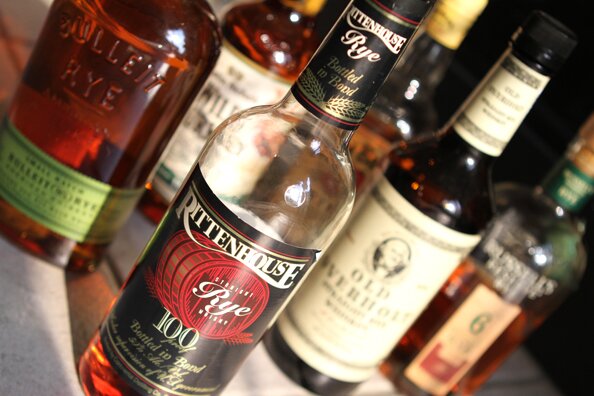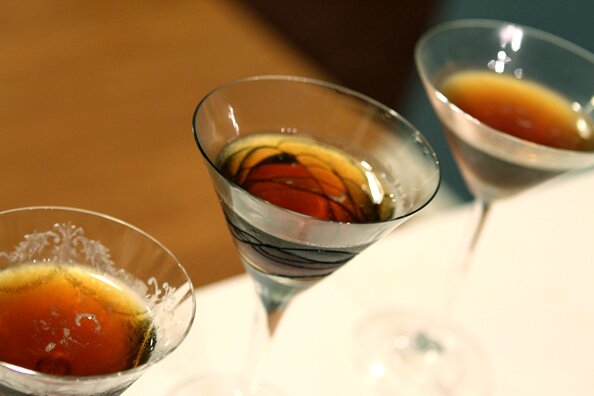
GUD FEATURE ARTICLE
Rye Tasting
Distilling rye has a history in America that extends back into the 1700s, a practice that was regularly undertaken by eastern settlers with surplus grain. George Washington was even among those who made whiskey from his rye, a fact which certainly must qualify it as one of our country’s classic spirits. Hence, Gourmet Underground Detroit felt it was our duty as Americans to taste through an assortment of this chronicled beverage.
Equal parts stout patriot and mad genius, my dear friend John thus organized a small group of folks — he and I were joined by Karla and Noah — to gather at his apartment in Northville to taste through a half dozen rye whiskeys.

Unfortunately, Sazerac brand rye, which is generally one of the commonly available ryes in Michigan, is in short supply at the moment, or so we were told by several store clerks in western Wayne County. But we had the other notable state-sanctioned products — Jim Beam, Wild Turkey, Russell’s, and Bulleit — as well as two ryes that are among the most popular across the counry in the form of Old Overholt and Rittenhouse 100.
None of these are terribly expensive, and we intentionally ignored products like the $200 aged Rittenhouse product or the “Ri” whiskey from Jim Beam, which at $40+ on the retail shelf isn’t something with which most people would be interested in mixing.
Setting aside our observations and opinions for a couple of paragraphs, it’s worth mentioning a few basic facts about rye, especially considering that it has a pretty limited following in the metro Detroit area.
Whiskey of all sorts is essentially just a distillation of a rudimentary beer. Most whiskey we drink has been aged in barrels for some length of time. Bourbon, arguably the more familiar whiskey to most Americans and certainly to most Detroiters, contains at least 51% corn in that grain mixture. Rye, by contrast and by law, must contain at least 51% rye. The remainder of the grain bill can be just about anything, though in the case of rye whiskey, those grains are generally corn, wheat, and/or malted rye.
Maryland, Pennsylvania, New York, and Virginia were all states noted for their rye traditions, with unique characteristics ascribed to each. After WWII, many of the notable bottlers were bought up and shut down or sold again, and those that stayed open were gobbled up by larger companies. Indeed, Pikesville, a perfectly pleasant drink with a nice fruity nose and smooth flavor, is a whiskey long associated with Maryland. But it’s now manufactured in Kentucky, “rescued” by Heaven Hill distilleries. The same applies to Rittenhouse, a brand in our tasting that represents Pennsylvania rye.
Indeed, as with most spirits, the landscape changed considerably after Prohibition. Bourbon gained favor with whiskey drinkers, and vodka seemed to catch on with everyone else.
Fortunately, we’re in the midst of something of a rye renaissance. In addition to the large-scale products that are enjoyable – like Rittenhouse or Overholt – producers like Tuthilltown, Anchor, and Whistlepig are creating new, smaller batch products that seem to be catching on for drinking straight or use in particularly high end cocktails.
In that spirit of renewal, here are our notes from the tasting. We drank the whiskeys blind, and the notes below are presented in the order in which the ryes were consumed.
Jim Beam Rye
The initial reaction from the entire crowd was that the whiskey didn’t taste like much of anything. There’s a slight sweetness with just a bit of vanilla barrel flavor and a mild spiciness. Very mild body. But beyond that, the Beam was inoffensive enough to be passable for cocktails but rather uninspiring otherwise.
 Russell’s Reserve 6
Russell’s Reserve 6
As Noah immediately mentioned, this was lighter in color than our first blind entry: Russell’s 6-year was more of a yellow-ish color than most whiskey. Aromatically, this was simply weak – not much there. On the palate, it was so bland as to be insipid. Karla didn’t get past two sips before passing hers off. There was barely a spiciness to it, something that one commonly expects in a rye, and it ended with a strange bitterness that, while mild, was off-putting. I’ve mixed Russell’s in plenty of drinks and not been too upset about it, but in this naked setting, it was clearly outmatched.
Bulleit Rye
Standing in stark contrast to the first two, this screamed with unique flavors and smelled of honey and herbs. I was somewhat alone in thinking that it had a thyme-ish quality in the nose. The spiciness was prickly but only accompanied by the most mild alcohol burn, and a light honey sweetness with a bit of toffee bitterness in the finish continued throughout the drink. It lasts a long while with that herbal, woody, toffee flavor making for a fairly savory rye. Of course, rye is the grain responsible for those flavors and for spice, so it should come as no surprise to newcomers to this product that it contains 95% rye, an unusually high percentage.
Rittenhouse 100
Arguably the most powerful of the ryes, this was obviously a 100 proof whiskey from the get go. In terms of complexity, it suffered coming immediately after the Bulleit. But as the most potent beverage in the tasting, spiciness and booze shone through with a mild, grassy finish. This is a clean, edgy whiskey that manages to be quite dry and full at the same time.

Old Overholt
Sort of a middling option from the first whiff, this had a bit of spice, a bit of sweetness, a bit of vanilla, and a bit of maple on the nose and honey on the palate. Lower in alcohol, it was immediately characterized as being rounder and while not widely rejected by our group, it wasn’t beloved either. Of course, this is still a value: It’s less than 15 bucks just about anywhere you can find it (not in Detroit), and in a pinch, it gets the job done. In the price range, it’s clearly a better option than Beam.
Wild Turkey
This is the most well-rounded whiskey. It had some body and some mild spice, but despite its higher proof, it’s not at all hot. And however it’s aged, it results in a pleasant, mild vanilla flavor. This whiskey also ranked highly with everyone, and considering the price and the fact it’s readily available in Michigan, it would arguably be our “go to” rye in the state.
* * * * * *
The Manhattan Project
Drinking straight whiskey is fun. No one would deny that. But in the interest of scientific exploration, we elected to make some Manhattans with the top three ryes from the tasting. If it wasn’t obvious from the notes, we chose to use Bulleit, Rittenhouse, and Wild Turkey.

John and Noah preferred the Bulleit best, whereas Karla preferred the Wild Turkey, and I preferred the Rittenhouse. The Bulleit certainly had a lot of flavors going on, though in my mind, it clashed a bit, adding a spicy smoke flavor to a drink that might not best carry those particular sensations. What one man considers complex might be another man’s confused, and vice versa. Wild Turkey carried its round, pleasant qualities through to the Manhattan and blended seamlessly. Rittenhouse created, for me, the most interesting drink: pleasant but not simple, complex but not awkward, spicy but not hot.
A certain someone hosting the tasting disagreed with my assessment and offered this unkind gesture:

It’s hard to lose with any of these three whiskeys — either for drinking straight or for drinking in a cocktail — but for Michiganders not looking to ship from out of state, Wild Turkey is the clear winner.
2011.06.29 Evan Hansen at 8:00 am
This entry was posted in Features and tagged cocktails, liquor, rye, tasting, whiskey. Bookmark the permalink.



3 Responses to Rye Tasting
Hey, you guys should have tried Grand Traverse Distillery Rye Whiskey:
http://www.grandtraversedistillery.com/whiskey/whiskey.html
They also have a Rye Vodka, one the best vodkas I have ever tasted.
Thanks, Jen, for reading… I knew GT made vodka but hadn’t heard about the rye. In fact, I’m pretty sure that I’ve ever actually seen the GT rye at any the stores in the Detroit area. Do you know where we can get it?
Nice writeup, Evan. Thanks, team, for taking a bullet for the rest of us.